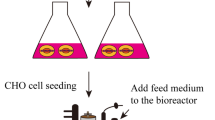Abstract
Monoclonal antibodies (mAb) are high added value glycoproteins recommended for immunotherapy, diagnosis, and also for the treatment of bacterial infections resistant to multiple drugs such as Methicillin Resistant Staphylococcus aureus (MRSA). In addition to environmental conditions related to cell cultures, the intrinsic characteristics of hybridoma cells, like the secretion stability of monoclonal antibodies by the cells through successive subcultures, are relevant for the characterization of cell lines related to the productivity of mAb. The rate of mAb production differs significantly between different cell lines and different passage numbers, and it is an important variable in characterization of cell lines. In order to find a more robust, faster-growing, and higher-productivity cell line of hybridoma, cultivations in 24-well plates were performed in different subculture periods, or cell passages (P), of hybridoma cells producing MRSA anti-PBP2a monoclonal antibodies [MRSA-antiPBP2a (mAb)]. The objective of this study was to study the effects of cell growth and production of MRSA-antiPBP2a mAb secreted by murine hybridoma cells grown in different passages as well as determine the which passages the hybridomas can be cultivated without harming their growth and productivity. So, cell growth profiles of hybridomas secreting MRSA-antiPBP2a (mAb) and the production of MRSA-antiPBP2a mAb in different subculture periods or cell passages (P) were studied. Cell growth tests, monoclonal antibody productivity, and metabolite characteristics revealed substantial differences in those cells kept between P10 and P50. Similarities in the secretion of monoclonal antibody, growth, and metabolic profiles, were noted in the MRSA-antiPBP2a mAb producing hybridoma cells kept between P10 and P20. Also, glucose consumption (g/L) and lactate production (g/L) in the latter cell cultures were monitored daily through biochemical analyzer. As of P30, it was observed a 4.4 times reduction in productivity, a 13 % reduction in metabolic yield, and a significant change in cell growth. Secretion of MRSA-antiPBP2a mAb should be obtained through the culture of hybridomas up to P20 in order to keep its stability.



Similar content being viewed by others
References
Acosta M, Sánchez A, García F, Contreras A, Molina E (2007) Analysis of kinetic, stoichiometry and regulation of glucose and glutamine metabolism in hybridoma batch cultures using logistic equations. Cytotechnology 54:189–200
Barnes LM, Bentley CM, Dickson AJ (2003) Stability of protein production from recombinant mammalian cells. Biotechnol Bioeng 81:631–639
Bebbington C, Yarranton G (2008) Antibodies for the treatment of bacterial infections: current experience and future prospects. Curr Opin Biotechnol 19:613–619
Beckmann TF, Kramer O, Klausing S, Heinrich C, Thute T, Buntemeyer H, Hoffrogge R, Noll T (2012) Effects of high passage cultivation on CHO cells: a global analysis. Appl Microbiol Biotechnol 94:659–671
Chen F, Ye Z, Zhao L, Liu X, Fan L, Tan W-S (2012) Correlation of antibody production rate with glucose and lactate metabolism in Chinese hamster ovary cells. Biotechnol Lett 34:425–432
Freshney RI (1994) Culture of animal cells: a manual of basic technique. Wiley, New York
Harris DC (2001) Análise Química Quantitativa, 2nd edn. LTC, Rio de Janeiro
Jang JD, Barford JP (2000) Effect of feed rate on growth rate and antibody production in the fed-batch culture of murine hybridoma cells. Cytotechnolgy 32:229–242
Kaur J, Badyal DK, Khosla PP (2007) Monoclonal antibodies: pharmacological relevance. Indian J Pharmacol 39:5–14
Kim M, O’Callaghan PM, Droms Ka, James DC (2011) A mechanistic understanding of production instability un CHO cell lines expressing recombinant monoclonal antibodies. Biotechnol Bioeng 108:2434–2446
Köhler G, Milstein C (1975) Continuous cultures of fused cells secreting antibody of predefined specificity. J Immunol (2005): 2453–2455. Reprinted with permission from nature (1975) 256: 495–497
Lee GM, Varma A, Palsson BO (1991) Appication of population balance to the loss of hybridoma antibody productivity. Biotechnol Prog 7:72–75
Legazpi L, Díaz J, Laca A, Díaz M (2005) Kinetic analysis of hybridoma cell culture in a protein-free medium: substrate and agitation effects. Biochem Eng J 26:122–130
Li L, Mi L, Qin J, Feng Q, Liu R, Yu X, Xu L, Chen Z (2006) Stability validation of seeding cell control parameters in large-scale hybridoma cell culture. Appl Microbiol Biotechnol 70:34–39
Li F, Vijayasankaran N, Shen AY, Kiss R, Amanullah A (2010) Cell culture processes for monoclonal antibody production. mAbs 2:466–477
Lim D, Strynadka CJ (2002) Structural basis for the β-lactam resistance of PBP2a from methicillin-resistant Staphylococcus aureus. Nat Struct Biol 9:870–876
Roshni LD, Jeno MS, Murray MY (1999) Hybridoma growth and productivity: effects of conditioned medium and of inoculum size. Cytotechnology 29:1–10
Schmid G, Blanch HW, Wike CR (1990) Hybridoma growth, metabolism, and product formation in hepes-buffered medium: effect of passage number. Biotechnol Lett 12:627–632
Selvey LA, Whitby M, Johnson B (2000) Nosocomial methicillin resistant Staphylococcus aureus bacteremia: is it any worse than nosocomial methicillin sensitive Staphylococcus aureus bacteremia. Infect Control Hosp Epidemiol 10:645–648
Senna JP, Roth DM, Oliveira JS, Machado DC, Santos DS (2003) Protective immune response against methicillin resistant Staphylococcus aureus in a murine model using a DNA vaccine approach. Vaccine 21:2661–2666
Stapleton PD, Taylor PW (2002) Methicillin resistance in Staphylococcus aureus: mechanisms and modulation. Sci Prog 85:57–72
Vallejos JR, Brorson KA, Moreira AR, Rao G (2009) Dissolved oxygen and pH profile evolution after cryovial thaw and repeated cell passaging in a T-75 flask. Biotechnol Bioeng 105:1040–1047
Xin H, Cutler JE (2006) Hybridoma passge in vitro may result in reduced ability of antibody to protect against disseminates candidiasis. Infect Immun 74:4310–4321
Zhu H, Yang ST (2004) Long-term continuous production of monoclonal antibody by hybridoma cells immobilized in a fibrous bed bioreactor. Cytotechnology 44:1–14
Acknowledgments
Authors are grateful and appreciated financial support from CAPES (Coordenação de Aperfeiçoamento de Pessoal de Nível Superior, Brasília, Brazil), Fiotec (Fundação para o Desenvolvimento Científico e Tecnológico em Saúde, Rio de Janeiro, Brazil), and Bio-Manguinhos Institute, Oswaldo Cruz Foundation/Fiocruz (Rio de Janeiro, Brazil).
Author information
Authors and Affiliations
Corresponding author
Rights and permissions
About this article
Cite this article
Corrêa, A.L., Senna, J.P.M. & de Sousa, Á.P.B. Effects of passage number on growth and productivity of hybridoma secreting MRSA anti-PBP2a monoclonal antibodies. Cytotechnology 68, 419–427 (2016). https://doi.org/10.1007/s10616-014-9794-0
Received:
Accepted:
Published:
Issue Date:
DOI: https://doi.org/10.1007/s10616-014-9794-0




